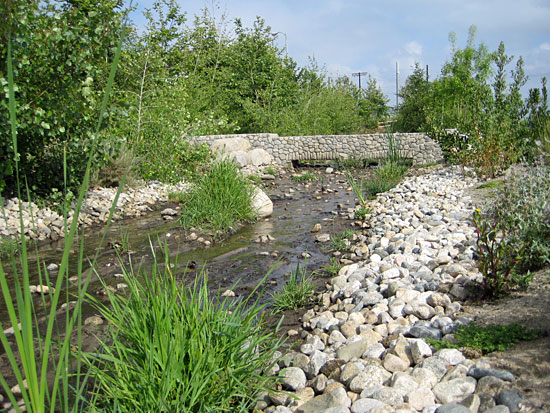Streaming live from the Valley
February 15, 2012

Phase I of the Tujunga Wash Ecosystem Restoration Project has already grown lush. Phase II is underway.
The San Fernando Valley is about to get a little greener. Phase II of the Tujunga Wash Ecosystem Restoration project breaks ground next Wednesday. By the time it’s completed, it will have restored ten acres of open space and created a sustainable stream system in the neighborhood of Valley Glen.
The $7 million project is a joint effort by the Los Angeles County Department of Public Works and the United States Army Corps of Engineers. The area to be restored is 3,000 feet long and 65 feet wide on each side of the wash. The finished section will link two existing “greenbelts”—Phase I of the project and an “original” greenway from the 1970s, forming 13,200 consecutive feet of revitalized land.
For the ecosystem, the project means nesting for migratory birds and a corridor for wildlife movement. Native vegetation will be installed, and the new stream will give local plants a chance to take root. The stream will replenish groundwater and act as a natural filter to urban runoff.
“The goal is to mimic Tujunga Wash in its natural state, but on a smaller scale,” said Richard Gomez, project manager for Department of Public Works.
For humans, the project offers a place to walk, learn and explore. Ornamental gates will mark entry points, a 12-foot-wide path will give pedestrians and bicycles room to meander and educational signage will teach visitors about the local ecosystem and the project itself. Benches and rock wall seating will offer folks a place to rest amid the greenery. Existing chain-link fencing will be replaced with more aesthetically pleasing material.
A ceremonial groundbreaking will take place at 10 a.m. on Wednesday, February 22, at the intersection of Vanowen Street and Fulton Avenue. Speakers include Supervisor Zev Yaroslavsky, Colonel R. Mark Toy and Public Works Director Gail Farber. The public is invited to attend.
The Tujunga Wash feeds into the Los Angeles River in Studio City. In the first half of the 20th century, repeated flooding of the channel caused widespread property damage and even some deaths. As a result, in the 1950s the Army Corps of Engineers lined nine miles of it with concrete. This and other human activity had the unintended effect of eliminating the natural habitat of the waterway.
The longterm hope is revitalization of the entire length of the Tujunga Wash, said Gomez. When the current project is completed this fall, that goal will be 3,000 feet closer.
Posted 2/15/12












 405 bridge work causes a stink
405 bridge work causes a stink
